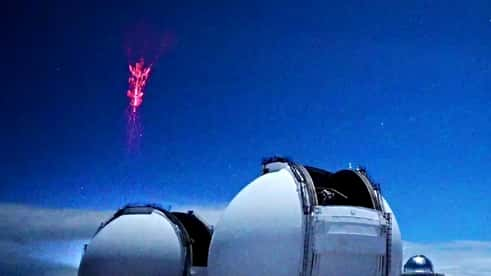Updated Feb. 9, 2023 2:14 PM EST
The Subaru-Asahi Star Camera perched atop Mauna Kea, Hawaii, captured a rare sighting of red sprites hovering above a distant thunderstorm on Feb. 5.
Hawaii offers incredible night sky views, making it an ideal location for telescopes to observe the night sky. On Feb. 5, 2023, a camera focused on the night sky over the Asahi-Shimbun and Subaru Telescope on the Big Island of Hawaii captured images of a rare weather phenomenon. A thunderstorm was rumbling in the distance behind the telescopes when multiple jellyfish-shaped lightning bolts called sprites appeared high in the sky.
Lightning sprites are much larger and more elusive than typical lightning during a thunderstorm. Unlike standard lightning flashes that are white and can strike the ground, sprites appear red or pink and extend upward over powerful thunderstorms, frequently reaching 30 to 56 miles (50-90 km) above the surface of the Earth. The Kármán line, which many scientists consider to be the edge of space, is 62 miles (100 km) above the Earth’s surface. Spites only last for a fraction of a second, making them incredibly challenging to witness.
Reports of sprite sightings date back hundreds of years but were not captured on camera until 1989. “Researchers from the University of Minnesota were testing a low-light TV camera for an upcoming rocket flight mission,” NASA explained. “By sheer accident, their camera captured the very first credible evidence for what we now call sprites.” Meteorologists have many unanswered questions about the formation of sprites since they are extremely difficult to observe and document. NASA has asked citizen scientists to file reports to help scientists study the electrifying phenomenon.
An image of Jupiter captured by the Cassini spacecraft on Dec. 7, 2000, as the space probe made its way through the solar system toward Saturn. (NASA/JPL/University of Arizona)
Jupiter is the largest planet in the solar system, but it ranked second in terms of the number of moons after Saturn, which has 83 confirmed moons in addition to its awe-inspiring rings. That is, until 2023.
Astronomers announced the discovery of 12 never-before-seen moons orbiting Jupiter, bringing its total number of confirmed moons to 92. Astronomer Scott Sheppard and a team of fellow scientists at the Carnegie Institution for Science in Washington, D.C., made the discovery, although it took around a year to confirm that the objects they were tracking were indeed orbiting the planet. Sheppard believes these moons could be remnants of at least seven larger moons that broke apart when they collided with other moons, asteroids or comets.
And that’s not all. The confirmed number of moons orbiting Jupiter could soon reach triple digits, with Sheppard saying that his team is working to confirm “many, many more moons around Jupiter.”
A cloud of icy molecules that could one day give birth to stars and planets. (NASA, ESA, CSA and M. Zamani (ESA))
The James Webb Space Telescope has captured breathtaking images of the cosmos since its launch on Dec. 25, 2021, including one picture of a region of space that could one day give birth to planets and stars.
The telescope recently observed a massive molecular cloud 630 light-years away from Earth, with its instruments detecting the presence of carbon, hydrogen, oxygen, nitrogen and sulfur inside the cloud. “These elements are important ingredients in both planetary atmospheres and molecules like sugars, alcohols, and simple amino acids,” NASA explained. “This is the most comprehensive census to date of the icy ingredients available to make future generations of stars and planets before they are heated during the formation of young stars.”
The blue, wispy material in the center of the image is the heart of the icy cosmic cloud, and the shimmering orange bursts of light on the left side of the image are young stars that have developed in the same region of space.
An image of the sun captured by the Solar Dynamics Observatory on Aug. 13, 2022. (NASA/SDO)
The sun has been bubbling with activity in recent months with solar flares frequently erupting on the surface of the star. Many of these eruptions have little to no impact on the Earth, but a 133-day timelapse released by NASA revealed how the surface of the sun has been bustling with activity since last summer.
The timelapse began on Aug. 12 and continued through Dec. 22, the day after the December solstice. In the video, the sun’s appearance is much different and more detailed than the human perspective from Earth (with proper eye protection, of course). That is because NASA’s instruments observe the sun through multiple wavelengths of light. Different wavelengths can help scientists identify different features on the sun’s surface, which can improve the accuracy of space weather predictions. “The loops extending above the bright regions are magnetic fields that have trapped hot, glowing plasma,” NASA explained. “These bright regions are also the source of solar flares, which appear as bright flashes as magnetic fields snap together in a process called magnetic reconnection.”
Larger outbursts on the sun can send clouds of charged particles at the Earth and spark vibrant displays of the northern lights. Intense solar activity could also cause issues with GPS systems, fluctuations with power grids on Earth and an increase in radiation exposure for astronauts on the International Space Station.








No comments:
Post a Comment